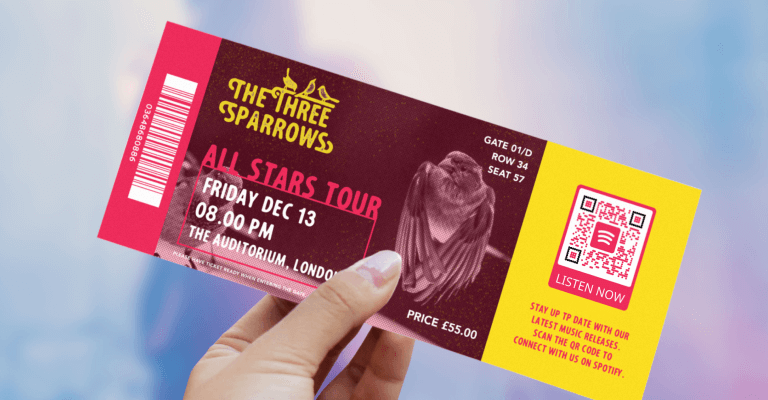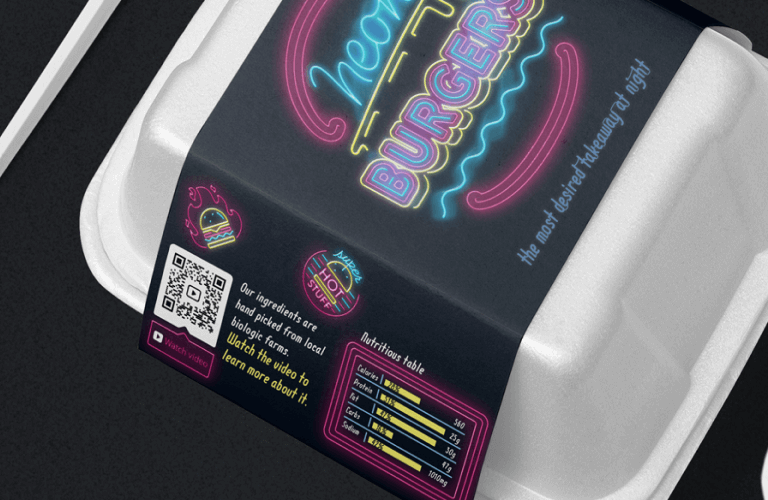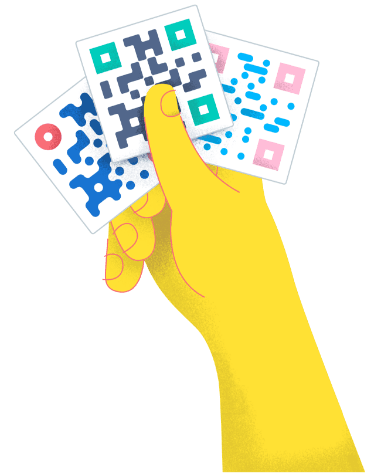- Best Practices ●
- COVID-19 ●
- Industry Trends ●
- Partners ●
- Product ●
How QR Codes in Pop Culture Influence Society
Pop culture is in a constant flux of change; trends come and go, like the shifts from winter to spring. Since the QR Code comeback during the coronavirus pandemic, they’ve stirred up quite the global conversation. More, they’ve become mainstream phenomenons. The reality is that we’re in the midst of a technological upsurge and QR Codes are becoming more accessible. Even now, you’re one click away from knowing just how to make a QR Code — best of all, your smartphone functions as your personal QR Code scanner. What’s not to love?
-
Table of contents
- What is pop culture?
- Why is pop culture important?
- What do QR Codes have to do with pop culture?
- QR Codes in pop culture: 6 topics that involve QR Codes
- #1 The music industry
- #2 Art: Comics, books, and films
- #3 Social Media platforms
- #4 Television and culture
- #5 Sports games
- #6 Food on social media
What is pop culture?
It sounds simple enough to define, but pop culture isn’t always easy to pinpoint because it’s always changing. In a nutshell, pop culture is a shared set of ideas, values, beliefs, and practices that are shared and recognized by us — society.
It is also called “mass media” which is everywhere — from the music we listen to, the influencers we follow on Instagram, the shows we stream on Netflix, the politics we engage in, to the relatable memes we laugh at. You know what I’m babbling about, right? The internet has democratized “popular culture” with a never-ending stream of new information by the millisecond — a contributing factor to why we can’t always zero in on what pop culture is.
Why is pop culture important?
The computers in our pockets keep us perpetually engaged in an ongoing conversation with mainstream culture. We’re inundated with its current trends at any given moment. So when people are making memes about the Netflix dating series, Love is Blind, a guilty pleasure for the masses, (don’t judge) it gives us a granular window into what society is entertained by, curious about, or what they value.
If you observe popular culture, you’ll find a treasure trove of juicy info about people. It can reveal what kind of conversations society is having within their echo chambers — and what they’re thinking about.
What’s unique about it in our contemporary context is how we participate in and influence it. Social media has given us a voice. You can tweet, post, or update stories about the latest pod on Spotify, a binge-worthy series on Showmax, or brag about your new Oculus quest.
What do QR Codes have to do with pop culture?
Tech and pop culture can’t be divorced; we depend on them for everything from our work, our entertainment, to our means of communication. It’s how we stay connected and informed.
One can’t deny that QR Codes have become a hot topic. It has a certain appeal to our society that’s worth paying attention to. If there’s ever been a doubt about whether QR Codes are part of mainstream culture, look no further than Coinbase’s QR Code ad that aired, broke the internet, and sparked a global debate on Twitter.
This is only the beginning. Up until the pandemic, QR Codes were just humble custodians in the background, now they’re in the spotlight. What has changed? They’re part of the conversation. But beyond the buzz, they bring value. Hate to break it to you, but they’re part of pop culture now.
QR Codes in pop culture: 6 topics that involve QR Codes
If you haven’t noticed it yet, QR Codes are forming part of pop culture topics such as music, entertainment, literature, film, social media, television, sports, food, fashion, travel, fitness, and so much more. They have their role to play. Don’t believe me yet? Let’s take a look.
#1 The music industry
It goes without saying that the music industry has influenced pop culture. Music has gone through unparalleled evolution from Walkman cassette players, iPods, to audio streaming platforms. Tech development has been instrumental in music advancement.
Need a daily dose of sound for the soul? Spotify, one of the most popular audio-streaming platforms — for Gen Z and the Millennial generation, have 406 million active monthly listeners.
Spotify is so in-tune with their listeners’ taste (thank you, algorithm), that they can intuit the music genre, artists, and curated playlists to recommend to you. So if you got a song playing on repeat, you betcha Spotify will know about it.
What’s more, is that Spotify has created its own version of QR Codes to share its music.
Spotify’s marketing team unmistakably listened to the masses by noticing a growing interest in QR Codes. And who can blame them for paying attention?
The good news is that we’ve developed the software so you can market your music with our MP3 QR Code. Hooray! Musicians or artists can revel in the added benefit of using a QR Code for music promotion. Use our innovative technology to get your tunes out and bring happiness to your fans with your new single.

#2 Art: Comics, books, and films
Pop culture art has had a profound impact on society. Time and time again, novels and comic books have prompted filmmakers to create cinematic artistry, attracting a wider audience. One example of this is how the novel Neuromancer by William Gibson inspired the iconic movie series: The Matrix.
Keanu Reeves became a sensation overnight, and with the recent release of The Matrix Resurrections, a trend in the movie and actor has made a comeback as if no time has passed. That’s the very nature of pop culture; it’s constantly changing, trends come back from the past, and some wither away.
Another example of a brilliant adaptation from book to film is the comic book series, Batman. It made its first impression on the collective psyche in 1939. Ever since Batman has been one of those pop culture icons. The Batman series first aired on television in 1966, and earlier this March in 2022, it hit the theatres — and is becoming one of those current trends even before the release of the movie — slow clap to mastermind marketers.
The latest Batman OOH (out of home) advertising movie posters have been causing quite a stir with their cryptic messages. It shows the figure of Batman illuminated in red while fitting the shape of a question mark — and a QR Code directing you to watch the trailer.
This perfect placement of the QR Code forming part of the question mark — a reference to the supervillain character, The Riddler, is both a clever advertising gimmick but also an ominous hint of what’s to come in the movie. The QR Code feature in the dot lures viewers into the tale of Batman, and once again proves that QR codes are part of pop culture.
This impressive example of advertising can also be replicated in the cinema auditorium. This is the ideal location to advertise your movie. How often do you have a fully engaged audience glued to the screen, watching your epic trailer while devouring salty buckets of popcorn?
Whether you advertise your movie inside or outside the walls of the movie theatre, cinema advertising with QR Codes enables users to scan the QR Code and watch the trailer on their smartphones. Add a Video QR Code to your print or digital material of choice to make sure your movie is the next one on their must-watch list!
#3 Social Media platforms
Social Media usage is easily one of the most popular practices today — no surprise. But that wasn’t always the case. From its early days in 1997, it was a merely virtual communication hub, and certainly not a marketing tool for businesses like it is today.
Over the years new social media platforms have popped up, some gained popularity, and some faded into the background. Among the most popular social media platforms, today are YouTube, Facebook, TikTok, LinkedIn, Instagram, and Twitter.
Social media has to be the culprit when it comes to influencing pop culture. It’s the source from which a waterfall of trends overflows. If you want to catch up on the most current popular culture trends, hopping on socials is how you stay up to date.
Following suit from apps like WeChat, many social media platforms have integrated a QR Code feature on their platforms — the perfect segway to promote more normalcy around the use of QR Codes.
To hype it up even more on popular culture breeding ground — by that I mean social media — this is the opportune time for businesses to guide their audience to their other social media accounts where they have different digital content. This can be done effortlessly with the state-of-the-art Social Media QR Code. If you want to get your followers from one platform to the other, model the fictional company, Femme Fitness below.

#4 Television and culture
Contrary to popular belief, television isn’t dead. Still, it continues to form societal perceptions from the news we watch, TV commercials, to cable TV. In the USA, it has shaped the way Americans think and perceive race, gender, and class — as well as forming political opinions. Television also happens to be the medium in which the society at large — beyond America — has been exposed to American culture.
TV viewership may have been warned in some ways, but in many other aspects, it maintained its relevance. More, television has discovered how to stay ahead of the curve and keep a steady viewership — with QR Codes.
It works because of the second screen phenomena: using other digital devices like a tablet, smartphone, or e-book while watching TV. These two actions performed in tandem influence how viewers engage in TV.
So with QR Codes popping up on television, it creates conversation around them — it prompts users to find out what happens when they scan that particular code. In the news segment below, CNN nudges their viewers to take action: to scan the QR Code and listen to their podcast Amanpour. In this instance, QR Codes direct them to either Spotify or Apple Music to help further educate viewers about the latest up-to-date news from TV to a podcast platform.
#5 Sports games
You can’t speak about pop culture without mentioning sport. Where’s there’s a sporting match, there’s a crowd: even since the humble beginning of sports broadcasting in 1911, 1000 people gathered to watch a football match between Kansas and Missouri.
Season after season, sport entertains a wide audience. Fans, from young to old, gather in front of their television sets in support of their favorite sports club, team, or player. If sport wasn’t part of pop culture, there wouldn’t be so much hype around the Olympics, the Soccer World Cup, or Tour de France.
But watching on TV screens isn’t the only way to stream live matches, now we have smartphones to do just that. Sky Go seized this opportunity by advertising its app with QR Codes. There’s nothing like creating a convenient experience for people to enjoy live sports events wherever they are — without fretting about the location.
Sky Go, a live football app made it a reality for Germans to watch the live Champions League on their smartphones. But to grab the attention of the crowd, Sky Go displayed interactive QR Codes during the match between Real Madrid and Schalke 04. In real-time, the audience scanned the QR Code which granted them access to part of the match, teasing the crowd to find out more about Sky Go on their website.
The SKY Go QR Codes may seem to obstruct your view at first glance, but the actual overlay of the QR Codes on top of the soccer players gives a special effect to the players’ movements. I don’t see how QR Codes wouldn’t be a hot topic of conversation after a stunt like this.
Sky Go’s app promotion is pure wizardry. But you don’t always need fireworks to attract users to your app. Take a simple approach by using an App QR Code on your social media, print materials, or your website.
#6 Food on social media
The world is split up into two groups of people: people who live to eat and people who eat to live. Depending on your cultural background, the way you think about food determines which group you belong to. But it doesn’t negate the fact that food is a hot topic around the globe — and why wouldn’t it be?
But what makes food part of pop culture is how trendy it has become. Vegan diets are in, carnivore diets are fading out. You’re either a foodie, or you’re not. The media is partly responsible for many of our perceptions around how we view food. From the food vlogs we watch on YouTube to the influencers/celebrities who post about the trendiest food brand on socials, food has blown up in pop culture.
Marketing gurus who analyze mainstream culture trends for a living understand it’s not always an easy job for businesses to satisfy a trend-hopping generation. That’s why we have a couple of tricks up our sleeve on how can stay trendy and cater to your target audience — with QR Codes — more specifically: QR Codes on food packaging.
Placing a QR Code on packaging makes digital information about a product more accessible to customers. Consumers want to know the where’s, the what’s, and the how’s of everything they’re buying. If you have a supply chain video or article you want to share with your target audience, creating a Video QR Code or Dynamic URL QR Code and placing them on your packaging is a sure way to build trust with your customers.

There’s a relationship between QR Codes and pop culture; a back and forth exchange, where they influence each other. As a society in the information age, we’re susceptible to jumping on social trends. When enough people are buzzing about the new salad, new series, or new song, on the interwebs, it doesn’t take much time to capture our attention.
We are daily consumers of pop culture. More often than not, we’re not even cognizant of our daily consumption because its become part of our daily diet. We’re more connected globally than ever before. And QR Codes are the gateway from offline to online. If you want to keep up with the zeitgeist, don’t be surprised when QR Code makes an appearance.






 Add custom colors, logos and frames.
Add custom colors, logos and frames.

